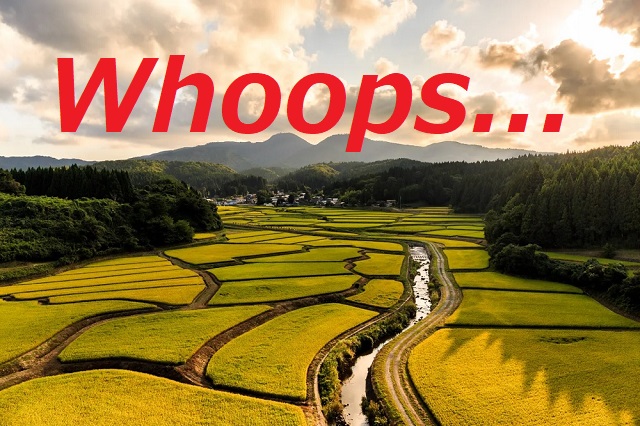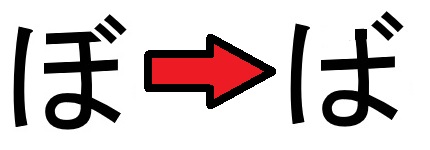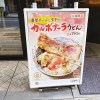
Mistake took months to be noticed, but it’ll be sticking around.
As we head towards mid-summer, Japan’s rice paddies take on extra-vibrant hues, and some become doubly beautiful thanks to the recent trend of rice field art. By planting differently colored strains of rice plants in carefully laid out arrangements in the spring, or strategically leaving certain parts of the field bare, come summer beautiful images will emerge as an agricultural mosaic.
Motoyama, Kochi Prefecture, may not get as intricate as the towns that put together salutes to Godzilla and Dragon Quest, but its farmers have been creating rice field art since seven years ago, often using rice to spell out messages in Japanese script, which itself has a highly artistic quality. For this year, as Japan continues to struggle under pandemic conditions, Motoyama wanted to boost the spirits of people across the nation, and so they chose to write out “Ganbarou Nihon!” or, “Hang in there, Japan!” Perhaps to give it an extra-friendly feel, they also decided to write ganbarou not in kanji characters, but in the more rounded type hiragana phonetic text.
▼ Ganbarou Nihon
But rice field art isn’t like creating with a pencil or brush, where you can see the results just seconds after deciding what strokes to take. Even after the farmers have planned everything out and planted the seeds, they still have to wait months in order to see it. Rice field art is also too large in scale to comprehend while you’re standing right next to the paddy yourself, so you need a raised vantage point to really appreciate it.
With summer here, though, it’s time to see how Motoyama’s rice paddy art turned out.
Pretty good, huh? Sure, the rustic penmanship (ricemanship?) might not please some overly strict calligraphy teachers, but considering the medium the farmers are working with, the message is impressively legible.
…except, wait. In the video, the rice art looks like this…
…and Ganbarou Nihon is this.
See the difference?
It’s a minor one, but that extra horizontal line in the third character changes the reading from “ba” to “bo.” So instead of Ganbarou/hang in there, Motoyama’s rice field art says “Ganborou,” which doesn’t mean anything.
▼ It’s not clear when anyone first noticed the mistake, but it was visible at least as early as June 28, when this video was uploaded to YouTube.
However, this doesn’t mean that Motoyama’s art project for 2021 is a failure, If anything, the rice-rendered typo is bringing the field extra attention, which is in turn bringing extra smiles to people’s faces, if online reactions like these are anything to go by:
“I can’t hate this.”
“I think it’s wonderful that they’re just rolling with it.”
“I’ve got no problem letting this slide. It’s cute and soothingly heartwarming.”
“Definitely made me smile.”
“It’d be cool if the town started selling manju sweet bean cakes with ‘Ganborou Japan’ written on them.”
“KWAII!”
There’s obviously no undo button for rice field art, but honestly, the mistake wouldn’t be too hard to correct if Motoyama really wanted to. Since the incorrect bo character is the one with the extra line, all they’d really have to do is bring in some sort of greenery to fill it in and effectively “erase” the problem.
▼ Like this
However, there are no plans to do that. “This is the charm you can only get from hand-made art,” said the local farmer’s organization, “and we could all use a little laughter as medicine these days.” And really, the reminder that things can still be good even when they’re not perfect, and that even if we make minor mistakes things can still turn out OK, is uplifting in a special way that a perfectly spelled message would have been.
Source: YouTube/【公式】日テレNEWS via Golden Times
Top image: Pakutaso (edited by SoraNews24)
Insert images ©SoraNews24
● Want to hear about SoraNews24’s latest articles as soon as they’re published? Follow us on Facebook and Twitter!
Follow Casey on Twitter, where he apologizes to any Snickers fans for not being able to work a “great googly moogly” reference into this article.





 Japanese town’s beautiful rice paddy art salutes Osamu Tezuka anime characters, Audrey Hepburn
Japanese town’s beautiful rice paddy art salutes Osamu Tezuka anime characters, Audrey Hepburn Dragon Quest celebrates anniversary with enormous rice paddy art in Gyoda, Japan【Video】
Dragon Quest celebrates anniversary with enormous rice paddy art in Gyoda, Japan【Video】 Godzilla appears in northern Japan as awesome rice paddy art 【Photos】
Godzilla appears in northern Japan as awesome rice paddy art 【Photos】 Shimane Prefecture’s shrine-headed mascot is now an adorable rice field
Shimane Prefecture’s shrine-headed mascot is now an adorable rice field Stunning Saitama rice field art snags Guinness record
Stunning Saitama rice field art snags Guinness record Red light district sushi restaurant in Tokyo shows us just how wrong we were about it
Red light district sushi restaurant in Tokyo shows us just how wrong we were about it Historical figures get manga makeovers from artists of Spy x Family, My Hero Academia and more
Historical figures get manga makeovers from artists of Spy x Family, My Hero Academia and more Tokyo Tsukiji fish market site to be redeveloped with 50,000-seat stadium, hotel, shopping center
Tokyo Tsukiji fish market site to be redeveloped with 50,000-seat stadium, hotel, shopping center Limited-edition Carbonara Udon will anger noodle purists and pasta lovers 【Taste test】
Limited-edition Carbonara Udon will anger noodle purists and pasta lovers 【Taste test】 Sandwiches fit for a sumo served up in Osaka【Taste Test】
Sandwiches fit for a sumo served up in Osaka【Taste Test】 Starbucks Japan adds a Motto Frappuccino to the menu for a limited time
Starbucks Japan adds a Motto Frappuccino to the menu for a limited time McDonald’s new Happy Meals offer up cute and practical Sanrio lifestyle goods
McDonald’s new Happy Meals offer up cute and practical Sanrio lifestyle goods Beautiful Red and Blue Star luxury trains set to be Japan’s new Hokkaido travel stars
Beautiful Red and Blue Star luxury trains set to be Japan’s new Hokkaido travel stars Pokémon Sleep camping suite and guestrooms coming to Tokyo Hyatt along with giant Snorlax burgers
Pokémon Sleep camping suite and guestrooms coming to Tokyo Hyatt along with giant Snorlax burgers Akihabara pop-up shop sells goods made by Japanese prison inmates
Akihabara pop-up shop sells goods made by Japanese prison inmates All-you-can-drink Starbucks and amazing views part of Tokyo’s new 170 meter-high sky lounge
All-you-can-drink Starbucks and amazing views part of Tokyo’s new 170 meter-high sky lounge More foreign tourists than ever before in history visited Japan last month
More foreign tourists than ever before in history visited Japan last month Japanese ramen restaurants under pressure from new yen banknotes
Japanese ramen restaurants under pressure from new yen banknotes French Fries Bread in Tokyo’s Shibuya becomes a hit on social media
French Fries Bread in Tokyo’s Shibuya becomes a hit on social media Studio Ghibli releases new action figures featuring Nausicaä of the Valley of the Wind characters
Studio Ghibli releases new action figures featuring Nausicaä of the Valley of the Wind characters New private rooms on Tokaido Shinkansen change the way we travel from Tokyo to Kyoto
New private rooms on Tokaido Shinkansen change the way we travel from Tokyo to Kyoto Starbucks reopens at Shibuya Scramble Crossing with new look and design concept
Starbucks reopens at Shibuya Scramble Crossing with new look and design concept Studio Ghibli glasses cases let anime characters keep an eye on your spectacles
Studio Ghibli glasses cases let anime characters keep an eye on your spectacles Beautiful Ghibli sealing wax kits let you create accessories and elegant letter decorations【Pics】
Beautiful Ghibli sealing wax kits let you create accessories and elegant letter decorations【Pics】 Studio Ghibli releases Kiki’s Delivery Service chocolate cake pouches in Japan
Studio Ghibli releases Kiki’s Delivery Service chocolate cake pouches in Japan New definition of “Japanese whiskey” goes into effect to prevent fakes from fooling overseas buyers
New definition of “Japanese whiskey” goes into effect to prevent fakes from fooling overseas buyers Our Japanese reporter visits Costco in the U.S., finds super American and very Japanese things
Our Japanese reporter visits Costco in the U.S., finds super American and very Japanese things Studio Ghibli unveils Mother’s Day gift set that captures the love in My Neighbour Totoro
Studio Ghibli unveils Mother’s Day gift set that captures the love in My Neighbour Totoro New Japanese KitKat flavour stars Sanrio characters, including Hello Kitty
New Japanese KitKat flavour stars Sanrio characters, including Hello Kitty New Pokémon cakes let you eat your way through Pikachu and all the Eevee evolutions
New Pokémon cakes let you eat your way through Pikachu and all the Eevee evolutions Disney princesses get official manga makeovers for Manga Princess Cafe opening in Tokyo
Disney princesses get official manga makeovers for Manga Princess Cafe opening in Tokyo Sales of Japan’s most convenient train ticket/shopping payment cards suspended indefinitely
Sales of Japan’s most convenient train ticket/shopping payment cards suspended indefinitely Sold-out Studio Ghibli desktop humidifiers are back so Totoro can help you through the dry season
Sold-out Studio Ghibli desktop humidifiers are back so Totoro can help you through the dry season Japanese government to make first change to romanization spelling rules since the 1950s
Japanese government to make first change to romanization spelling rules since the 1950s Ghibli founders Toshio Suzuki and Hayao Miyazaki contribute to Japanese whisky Totoro label design
Ghibli founders Toshio Suzuki and Hayao Miyazaki contribute to Japanese whisky Totoro label design Doraemon found buried at sea as scene from 1993 anime becomes real life【Photos】
Doraemon found buried at sea as scene from 1993 anime becomes real life【Photos】 Tokyo’s most famous Starbucks is closed
Tokyo’s most famous Starbucks is closed One Piece characters’ nationalities revealed, but fans have mixed opinions
One Piece characters’ nationalities revealed, but fans have mixed opinions We asked a Uniqlo employee what four things we should buy and their suggestions didn’t disappoint
We asked a Uniqlo employee what four things we should buy and their suggestions didn’t disappoint Princesses, fruits, and blacksmiths: Study reveals the 30 most unusual family names in Japan
Princesses, fruits, and blacksmiths: Study reveals the 30 most unusual family names in Japan Japan’s ‘agri-tech’ farming revolution
Japan’s ‘agri-tech’ farming revolution Welcome the New Year with a calendar of hunky Japanese farmers 【Pics】
Welcome the New Year with a calendar of hunky Japanese farmers 【Pics】 Video shows that Street Fighter V’s story mode is so easy even a baby can beat it 【Video】
Video shows that Street Fighter V’s story mode is so easy even a baby can beat it 【Video】 This Japanese man dated a cockroach, dreamed of having sex with it 【Video】
This Japanese man dated a cockroach, dreamed of having sex with it 【Video】 Beautiful mountain farmlands are yet another reason to visit rural Japan
Beautiful mountain farmlands are yet another reason to visit rural Japan Better than mosquito repellent – The most eco-friendly (and spiritual) way to repel pests in Japan
Better than mosquito repellent – The most eco-friendly (and spiritual) way to repel pests in Japan Enjoy sights and traditions of Japan’s heartland in new Gifu prefecture-focused feature【Video】
Enjoy sights and traditions of Japan’s heartland in new Gifu prefecture-focused feature【Video】 Pikachu Outbreak home robot walks, talks, and sings when you call to it【Video】
Pikachu Outbreak home robot walks, talks, and sings when you call to it【Video】 Mystery vegetable patch suddenly appears in the middle of Japan’s fourth-largest city【Video】
Mystery vegetable patch suddenly appears in the middle of Japan’s fourth-largest city【Video】 15 tons of sweet potatoes stolen in rural Japan, criminal crew may be targeting spuds
15 tons of sweet potatoes stolen in rural Japan, criminal crew may be targeting spuds Ghibli scarecrow protects rice fields in countryside Japan
Ghibli scarecrow protects rice fields in countryside Japan Nagoya University develops rice plant that grows pure sugar
Nagoya University develops rice plant that grows pure sugar Locust and wormwood soft serve ice cream now available in Japan!
Locust and wormwood soft serve ice cream now available in Japan! Conditions in North Korea so bad even the wildlife are making a break for it 【Video】
Conditions in North Korea so bad even the wildlife are making a break for it 【Video】 New hemp mascot character Asamiko-chan appears in Japan
New hemp mascot character Asamiko-chan appears in Japan How much more expensive is it to use microwave rice packs instead of cooking/freezing your own?
How much more expensive is it to use microwave rice packs instead of cooking/freezing your own?
Leave a Reply